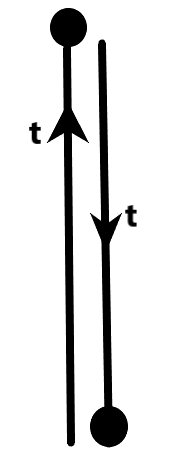
A player plays a ball upwards with an initial speed of 29.4\[m{{s}^{-1}}\]. Taking \[g=9.8m{{s}^{-2}}\], the time taken by the ball to return to the player’s hand is?
Answer
557.1k+ views
Hint: We need to understand the relation between the speed at which a ball is thrown and the time taken by the ball to return. We can easily find this using the equations of motion which will help us solve the required time in the given problem.
Complete step by step solution:
We know that a body thrown upwards with an initial velocity will return back to the ground after a time interval. The time taken for the body to return to the ground is determined by the velocity at which the object was thrown initially.

The velocity of the ball will become zero once the ball is at the maximum height of its motion. The time taken to reach the maximum height will be half the total time taken by the ball to reach the ground at the point from where it is thrown.
By applying the equation of motion, we can find time taken to reach the maximum height as –
\[\begin{align}
& v=u+at \\
& \Rightarrow t=\dfrac{v-u}{a} \\
& \Rightarrow t=\dfrac{0-29.4m{{s}^{-1}}}{-9.8m{{s}^{-2}}} \\
& \therefore t=3s \\
\end{align}\]
The time taken for the total trip will be twice the time taken for ascent alone.
i.e.,
\[\therefore {{t}_{total}}=6s\]
The time taken for the ball to return to the player’s hand after his throw is 6 seconds.
This is the required solution.
Note:
The ball when thrown upwards converts its kinetic energy to potential energy. Once the kinetic energy is completely converted to the potential energy, the velocity of the ball in the air will be zero at a point. This will be maximum height attained by the ball.
Complete step by step solution:
We know that a body thrown upwards with an initial velocity will return back to the ground after a time interval. The time taken for the body to return to the ground is determined by the velocity at which the object was thrown initially.

The velocity of the ball will become zero once the ball is at the maximum height of its motion. The time taken to reach the maximum height will be half the total time taken by the ball to reach the ground at the point from where it is thrown.
By applying the equation of motion, we can find time taken to reach the maximum height as –
\[\begin{align}
& v=u+at \\
& \Rightarrow t=\dfrac{v-u}{a} \\
& \Rightarrow t=\dfrac{0-29.4m{{s}^{-1}}}{-9.8m{{s}^{-2}}} \\
& \therefore t=3s \\
\end{align}\]
The time taken for the total trip will be twice the time taken for ascent alone.
i.e.,
\[\therefore {{t}_{total}}=6s\]
The time taken for the ball to return to the player’s hand after his throw is 6 seconds.
This is the required solution.
Note:
The ball when thrown upwards converts its kinetic energy to potential energy. Once the kinetic energy is completely converted to the potential energy, the velocity of the ball in the air will be zero at a point. This will be maximum height attained by the ball.
Recently Updated Pages
Master Class 11 Business Studies: Engaging Questions & Answers for Success

Master Class 11 Computer Science: Engaging Questions & Answers for Success

Master Class 11 Maths: Engaging Questions & Answers for Success

Master Class 11 Chemistry: Engaging Questions & Answers for Success

Master Class 11 Economics: Engaging Questions & Answers for Success

Master Class 11 Accountancy: Engaging Questions & Answers for Success

Trending doubts
What is meant by exothermic and endothermic reactions class 11 chemistry CBSE

10 examples of friction in our daily life

One Metric ton is equal to kg A 10000 B 1000 C 100 class 11 physics CBSE

1 Quintal is equal to a 110 kg b 10 kg c 100kg d 1000 class 11 physics CBSE

Difference Between Prokaryotic Cells and Eukaryotic Cells

What are Quantum numbers Explain the quantum number class 11 chemistry CBSE




